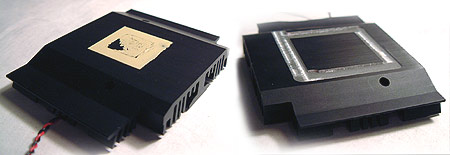
TOP 5 Heat Sinks TOP 5 Low Profile Heat Sinks TOP 5 Liquid Coolers
Heatsinks by Brand / Mfgr Reviews + Articless Advanced Search
 |
TOP 5 Heat Sinks TOP 5 Low Profile Heat Sinks TOP 5 Liquid Coolers Heatsinks by Brand / Mfgr Reviews + Articless Advanced Search |
The next task was to drill a very small hole in the base of the modified heatsink, and in a second unmodified stock heatsink so we could insert the thermocouple and draw some comparisons between the two. In the picture below you can see an overlay of the base showing a red arrow pointing to the location of the hole. We used an Omega HH501DK Thermometer with a Type K Thermocouple to record the subsequent temperature readings as shown in the general configuration.
Since these results are based on real world measurements there will be some degree of uncertainty, but to curb that as much as possible we followed a standard procedure for preparing the card for measurement. Once installed into a system (with heatsink and thermocouple), the Radeon 9700 was put through a few rounds of 3DMark 2001 to warm up first. We then ran the card through three sets of tests and took the average of the maximum temperatures reached. While the temperature of the core hovered around 45.7 degrees for most of 3DMark2001, the GPU intensive tests bumped up the heat output to fairly consistent levels.
Based on an ambient room temperature of 20.9 degrees Celsius we found that the unmodified stock heatsink with standard silicon thermal compound reached a temperature of 58.0 degrees Celsius. The modified stock heatsink with the same type of thermal compound reached an average temperature of 55.6 degrees Celsius, which is a difference of about 2.3 degrees Celsius. On this particular Radeon 9700 card there was no perceptible difference in the ability to overclock the core.  So what can we make of all this? Well, the difference in temperature between a flush mounted stock heatsink and one which sits above the core (with standard white silicon heatsink compound) is pretty marginal. A better thermal compound would have no doubt provided better results, but for those of you jumping to grab you tubes of silver based compound - remember that there are electrical components located close by that conductive thermal compound could pose risk to. Would the R300 run cooler without the shim's interference? Yes. Is it a major concern for users running their systems at stock speeds? No. If you're looking to really push your
Radeon 9700, perhaps with an after market cooler, this is something that can
potentially stand in the way - so now you know. Heatsinks like Zalman's ZM80A-HP
however, have the necessary undercut (about 0.3mm relief) to fit properly on the R300 core without having to use a huge amount of thermal compound. We tested the card with adequate amounts of thermal
compound so that heat could travel, but if you have decided to remove the yellow
TIM, double check that you've used enough replacement compound. The last thing
anyone wants is an unstable card because the core is not in contact with
any type of cooling device!
|
|
|||||||||||||||||||||||||||||||||
|
Find a Heatsink . Latest Heatsink Reviews . Top 5 Heatsinks Tested . Top 5 Low Profile Heatsinks . Top 5 Liquid Coolers . Heatsinks by Mfgr / Brand |
Social Media |
FrostyTech.com Info . Feedback . Contact Us / Heatsink Submissions . Submit News . Privacy Policy |
 | |
© Copyright 1999-2025 www.frostytech.com All Rights Reserved. Privacy policy and Terms of Use Images © FrostyTech.com and may not be reproduced without express written permission. Current students and faculty of accredited Universities may use Frostytech images in research papers and thesis, provided each image is attributed. | ||||